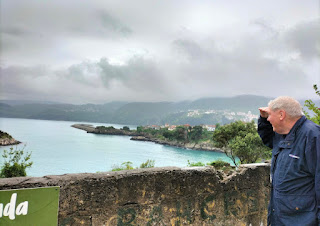Western Black Sea 2
I fell in love with Amasra when I saw this picture on the internet.
Unfortunately, like a bad Tinder date, the reality – on a damp and chilly morning – was a little disappointing. No matter. There was still plenty to enjoy. We had stayed overnight at the North Door Hotel, a plush venue with its own striking sea views.
It was only a short walk to the point in the picture where a narrow bridge links two parts of the town. On the way, followed by two hungry street dogs, we spotted some ancient wooden houses, and some eclectic garden ornaments.
wooden houses brolly weather
garden booty hungry dog
A view from near the summit I see no (cruise) ships
Bits of the infrastructure of the photogenic bridge had been rebuilt with stone from the Roman period and an inscription in Roman lettering was crudely wedged at shoe level. We traipsed a meandering path upwards to a high vantage point where, in summertime, cafes would bustle with gawking visitors. Retracing our steps we eventually came to a museum where a Jobsworth on reception seemed to have trouble accepting the new-fangled digital museum card. Inside was a poster advertising The Art of Pulling. This was nothing to do with flirting, although there was a statue of a particularly comely and scantily-clad maiden, who must have turned heads in her time.
Next
stop was Safranbolu, a one hour and 23 minute ride away. Donovan might have sung about being mad about
saffron in his song Mellow Yellow.
I'm just mad about saffron,
A-saffron's mad about me
But to the 53,000 locals here the musky-smelling spice is far more important, a source of income and a lure for the tourists. Saffron, as every schoolboy and girl knows, is a collection of golden-coloured pungent stigmas (pollen-receiving structures) of the autumn crocus (Crocus sativus), which are dried and used as a spice to flavour foods, as a dye to colour foods and as an oil to rub onto your skin. Succumbing to a few vendors soon had our group smelling like a French bordello.
The small town bustled with quaint shops and restaurants, the architecture reminiscent of Sirince near Selcuk.
Here, certainly deep into the nineteenth century, Turks and Greeks lived and worked side-by-side. However, it does not appear to have given the world many notable famous people, except for Safranbolulu Izzet Mehmet Pasha, 18th century Ottoman Grand Vizier, in office 1794–1798 and journalist and author Ali Gümüş (1940–2015).
Next up was the Horma Canyon, a wonderful natural phenomenon, with pulsating water flows. Hearts-in-mouths, we stepped on a glass promontory over the abyss, mindful of a nearby sign forbidding "prancing". Nearby was an upside-down house, a children's play centre, complete with an upside-down car fixed to the roof.
Further on we were able to stroll along part of the canyon. The walkway runs (if that's appropriate) for three kilometers. Most of us managed just a few hundred meters on the combination of swaying bridge and fixed, slippery wooden slats, which claimed one victim, Keith, whose glasses were retrieved by Ali after he fell.
Horma Canyon






















Muhteşem
ReplyDelete